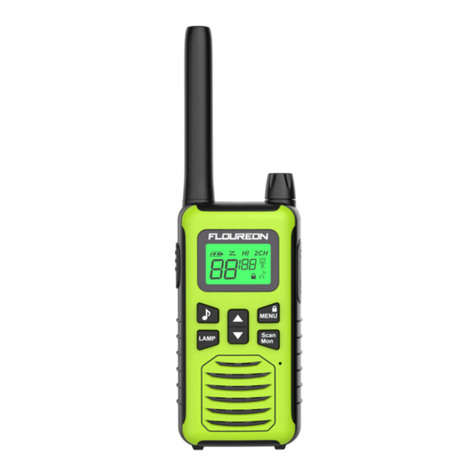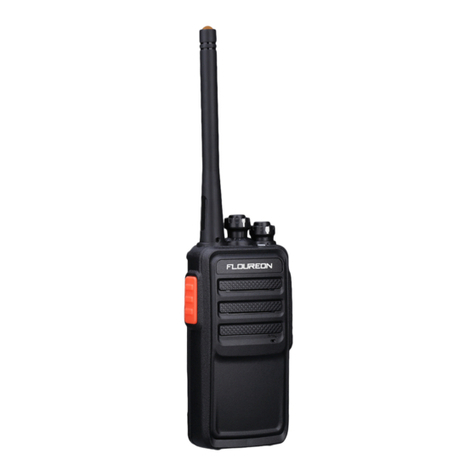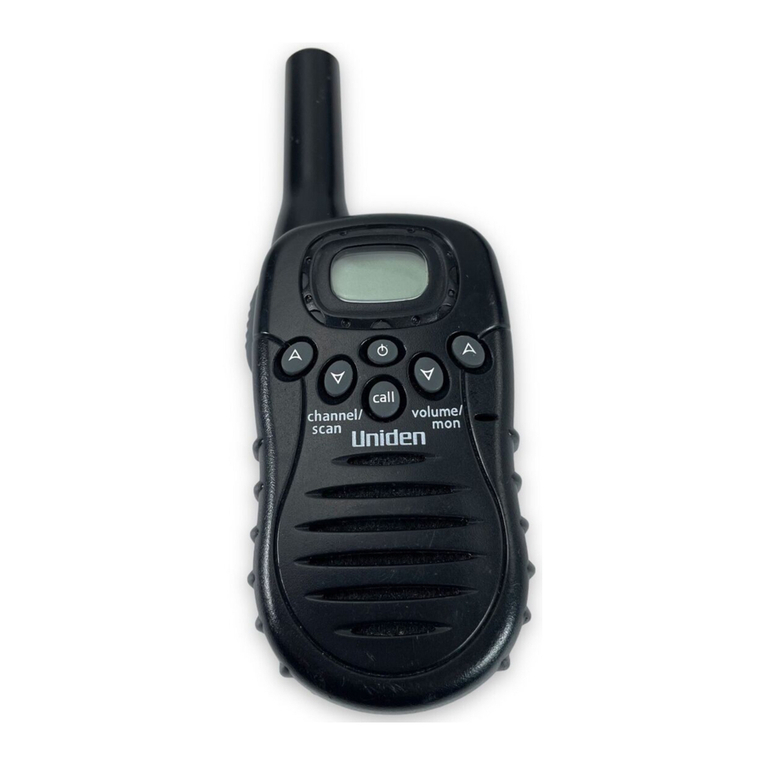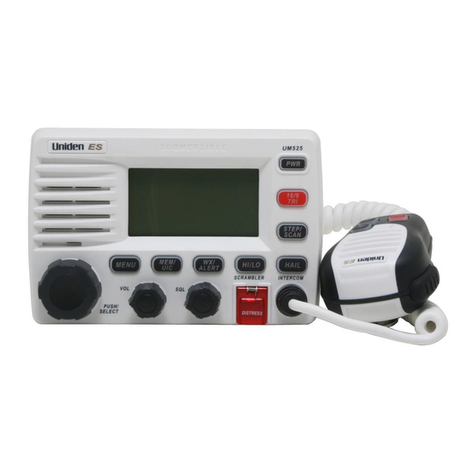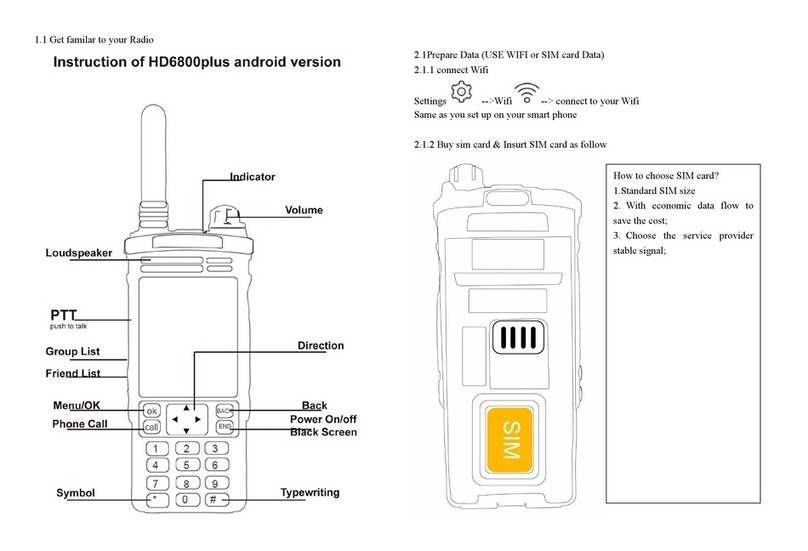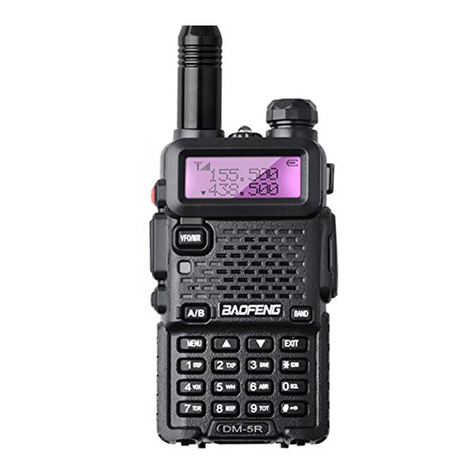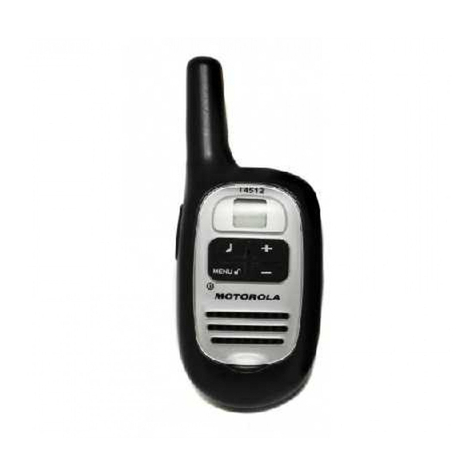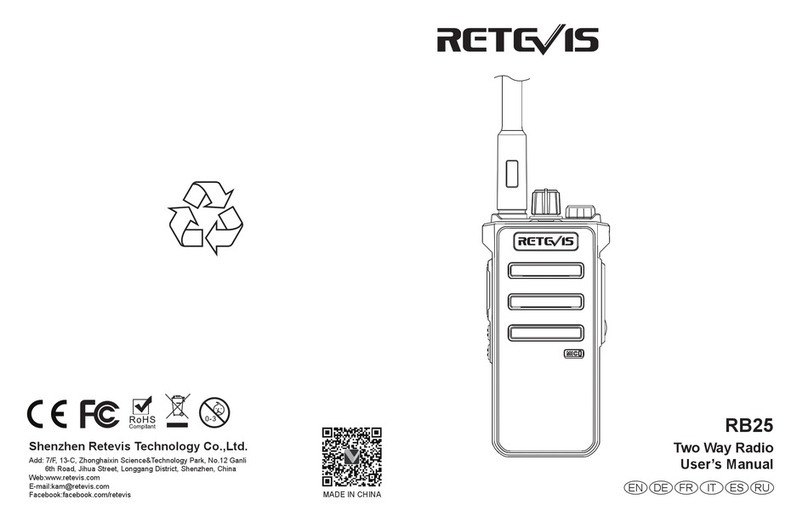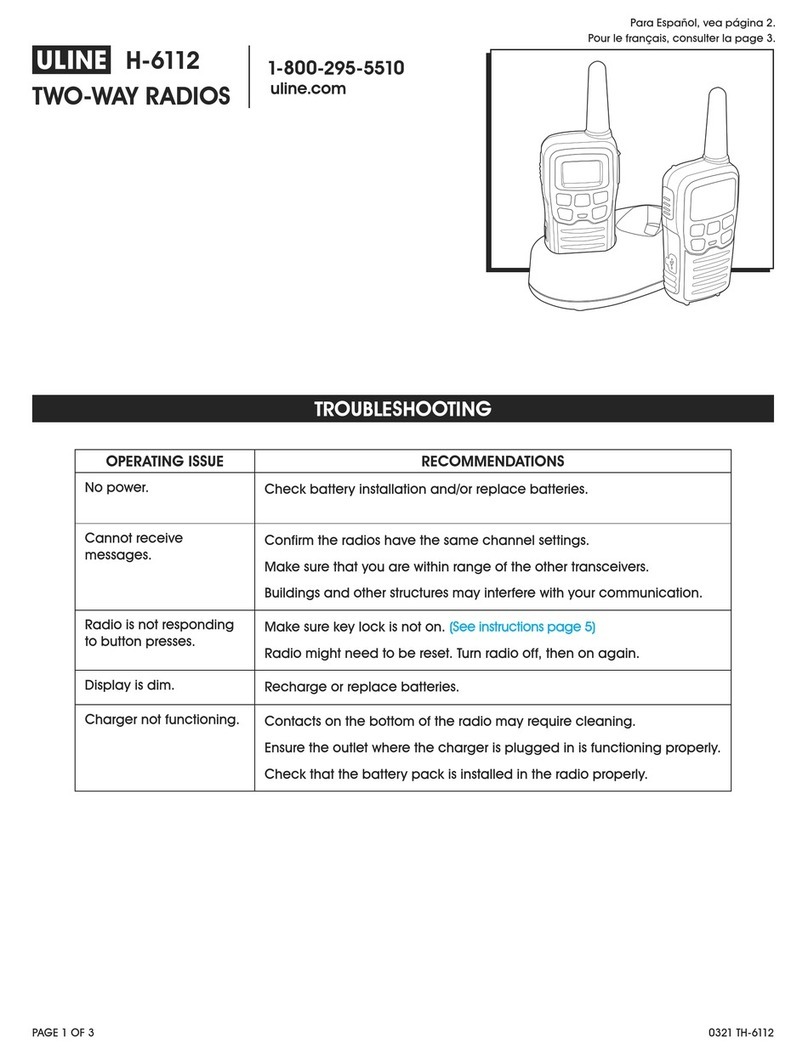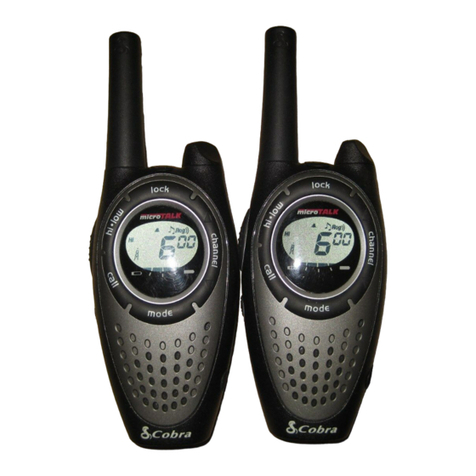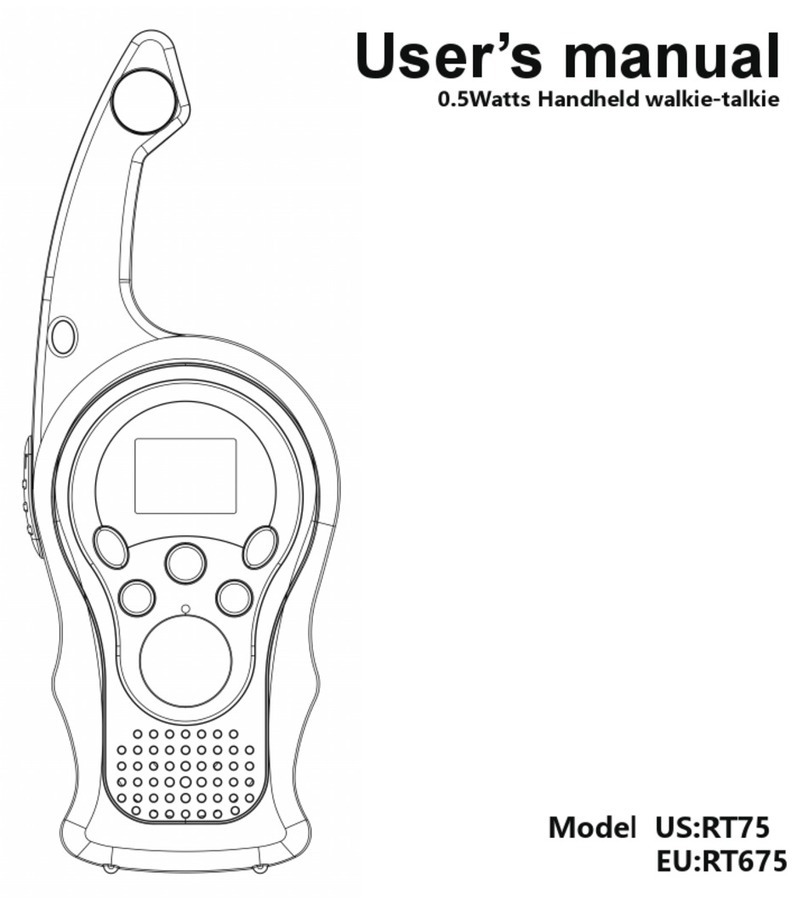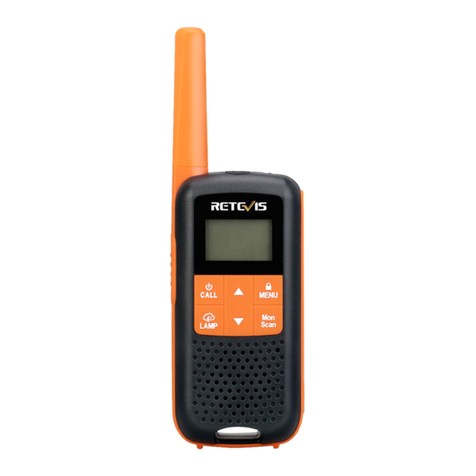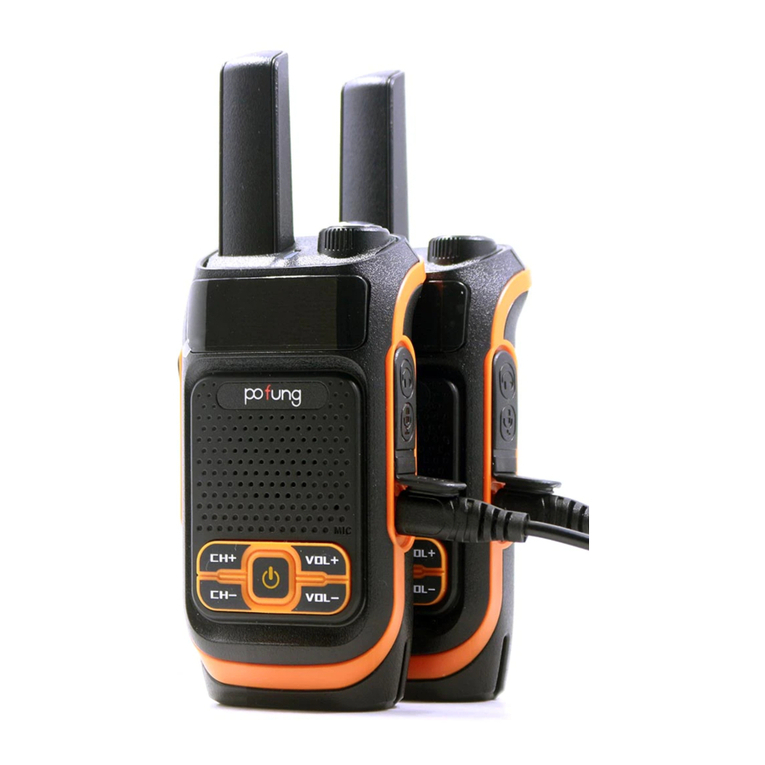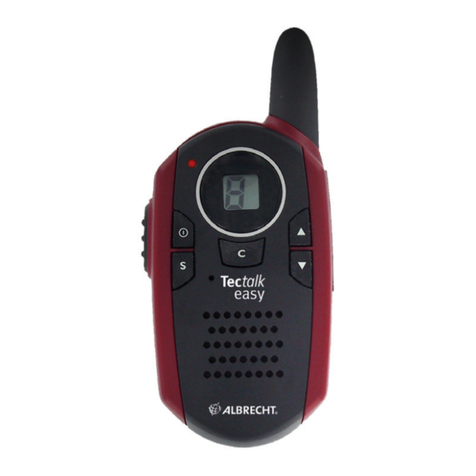Floureon FC100 User manual

FC100
TWO-WAY�RADIO
User�Manual
●���9�Channels�
●���Up�to�1.5km��range
●���5�call�tones�for�selection�
●���Call�Roger�Tone�
●���Keypad�Tone�
●���Auto�power�off�(1.5h)�
●���Keypad�Lock�
●���Auto�Squelch�Control
●���Battery�Save�
●���Low�Battery�Alert
●���TOT�(time-out�timer)�
●���Volume�(0-7)�
1.�Press�VOL[▲]�key�to�increase�the�
���volume�level.
2.�Press�VOL[▼/��]�key�to�decrease�the�
���volume�level�or�mute�the�speaker.
���NOTE:�
���Do�not�hold�the�radio�close�to�your�
���ear,�if�the�volume�is�set�to�
���uncomfortable�level,�it�could�hurt�you�
���hear.
1.�Remove�the�battery�cover.
2.�Insert�3�AAA�Alkaline�Batteries�with�+�
���and�-�polarity�as�shown�inside.
3.�Close�the�battery�cover�firmly.
Antenna
Channel+�key
Channel-�key/Call�tone�key
PTT�key
Note:�LED�only�displays�the�channel�
LED�display�
ON/OFF�key�
Volume+�key�
Volume-�key/Lock�key�
Microphone�
Speaker
Features�
1.�Press�and�hold�[��]�key�for�3�seconds�to�
���turn�the�radio�on�or�off.�
2.�Upon�power�on,�the�radio�chirps�and�
���briefly�shows�all�feature�icons�available�
���on�the�radio.
3.�The�display�screen�then�shows�the�
���current�channel,�and�all�features�that�
���are�enabled.
Turn�Radio�On�and�Off
Installing�the�Batteries
If�there�is�no�
responsein�1.5�hour,�
the�radio�will�turn�off�
automatically.
Auto�Power�Off
Keypad�Control�and�Function� Setting�the�Volume
1
23

Your�radio�can�transmit�different�call�
tones�to�other�radios�in�a�group�so�you�
can�alert�them�that�you�want�to�talk.
To�prevent�accidental�transmissions�and�
save�battery�life,�the�radio�emit�a�
continuous�warning�tone�and�stops�
transmitting�if�you�press�the�[Talk]�key�
for�60�seconds�continuously.
Setting�and�Transmitting�
Call�Tones� Your�radio�transmit�a�unique�tone�when�
you�finish�transmitting,�it�is�like�saying�
“Roger”�or�“Over”�to�let�others�know�
you�have�finished�talking.
Roger�Tone�
To�avoid�accidentally�change�your�radio�
settings.
1.�If�there�is�no�response�in�10�seconds,�
���the�radio�will�lock�the�keypad�
���automatically.
2.�You�can�also�press�and�hold�VOL�
���[▼/��]�key�to�lock�or�unlock�the�keypad�
���manually.
Keypad�Lock�
Talk�Timeout�Timer
Battery�Save�function�works�
automatically�to�save�battery�life.
Your�radio�is�idle�inactive�for�5�seconds,�
it�will�enter�battery�save�mode�
automatically.�Under�this�mode,�the�
walkie-talkie�can�receive�incoming�calls.
Battery�Save
Frequency�Table�
When�the�battery�power�is�low,�the�radio�
chirps�periodically(Low�Battery�Alert).�In�
battery�low�status,�the�radio�will�sound�
the�alert�every�5�minutes�or�after�
releasing�the�[Talk]�key.
NOTE:�
Remove�the�battery�from�radio�for�
storage�purposes.
Low�Battery�Alert
Your�radio�is�designed�to�maximize�
performance�and�improve�transmission�
range.�
NOTE:�
Do�not�use�the�
radio�closer�than�
five�feet�apart.�
The�channel�is�the�frequency�of�radio�
uses�to�transmit.
1.�Press�CH�[▲]�key�to�increase�the�
���channel�number.
2.�Press�CH�[▼/��]key�to�decrease�the�
���channel�number.
3.�The�radio�has�9�channels.
Selecting�the�Channel�
All�radios�in�a�group�should�set�to�the
same�channel.�
1.�Press�and�hold�[Talk]�key�while�s
���peaking.�
2.�Release�[Talk]�key,�you�can�now�
���receive�the�incoming�calls.�
3.�For�maximum�clarity,�hold�the�radio�2�
���to�3�cm�away�and�avoid�covering�the
���microphone�while�talking.
Talking�and�Listening��
Talk�Range
Frequency�of�America�
ChannelFrequency ChannelFrequency ChannelFrequency
1
462.56250
4462.63750
7
462.71250
2
462.58750
5
462.66250
8
467.56250
3462.612506462.687509467.58750
5
6
4
7
1.�Press�and�hold�CH[▼/��]key�for�2�
���seconds�to�transmit�the�call�tone,�press�
���and�hold�CH[▼/��]key�for�2�seconds�
���again�to�transmit��������the�next�call�
���tone.
2.�The�radio�has���������5�call�tones.��

FCC Statement
This device complies with Part 15 of the FCC Rules. Operation is subject to the following two conditions:
(1) This device may not cause harmful interference, and
(2) this device must accept any interference received, including interference that may cause undesired operation.
NOTE 1: This equipment has been tested and found to comply with the limits for a Class B digital device , pursuant to part 15 of the FCC Rules. These limits are
designed to provide reasonable protection against harmful interference in a residential installation. This equipment generates, uses and can radiate radio frequency
energy and, if not installed and used in accordance with the instructions, installed and used in accordance with the instructions, may cause harmful interference to
radio communications. However, there is no guarantee that interference will not occur in a particular installation. If this equipment does cause harmful interference
to radio or television reception, which can be determined by turning the equipment off and on, the user is encouraged to try to correct the interference by one or
more of the following measures:
- Reorient or relocate the receiving antenna.
- Increase the separation between the equipment and receiver.
-Connect the equipment into an outlet on a circuit different from that to which the receiver is connected.
-Consult the dealer or an experienced radio/TV technician for help.
NOTE 2: Any changes or modifications to this unit not expressly approved by the party responsible for compliance could void the user's authority to operate the
equipment.
SAR Warning
This transmitter may operate with the antenna(s) documented in this filing in Push-to-Talk and body-worn configurations. RF exposure compliance is limited to
the specific belt-clip and accessory configurations as documented in this filing and the separation distance between user and the device or its antenna shall be at least
2.5 cm. All qualified end-users of this device must have the knowledge to control their exposure conditions and/or duration to comply with General Population /
Uncontrolled Exposure limit and requirements. The highest reported SAR values for Face-held, body-worn conditions are 0.186 W/Kg, 0.330 W/Kg.
Other Floureon Two-way Radio manuals
